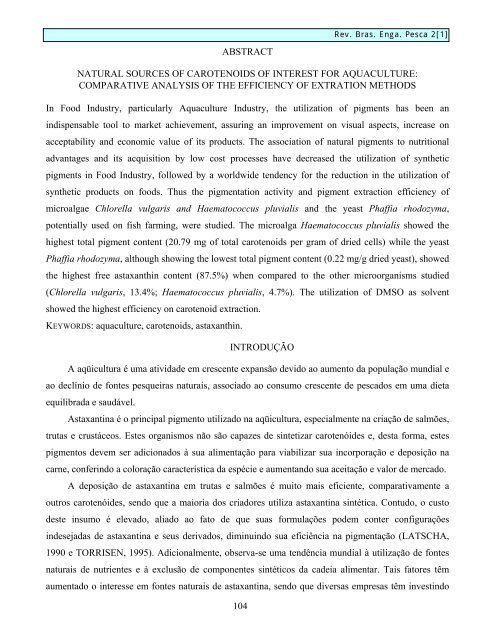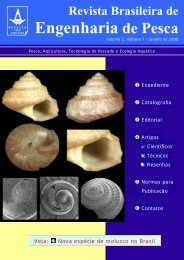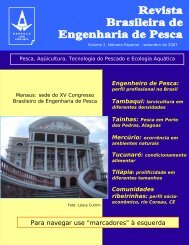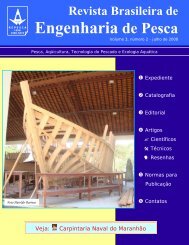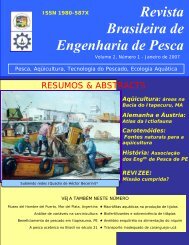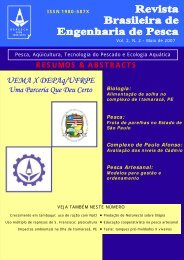Revista Brasileira de Engenharia de Pesca
Revista Brasileira de Engenharia de Pesca
Revista Brasileira de Engenharia de Pesca
You also want an ePaper? Increase the reach of your titles
YUMPU automatically turns print PDFs into web optimized ePapers that Google loves.
ABSTRACT<br />
104<br />
Rev. Bras. Enga. <strong>Pesca</strong> 2[1]<br />
NATURAL SOURCES OF CAROTENOIDS OF INTEREST FOR AQUACULTURE:<br />
COMPARATIVE ANALYSIS OF THE EFFICIENCY OF EXTRATION METHODS<br />
In Food Industry, particularly Aquaculture Industry, the utilization of pigments has been an<br />
indispensable tool to market achievement, assuring an improvement on visual aspects, increase on<br />
acceptability and economic value of its products. The association of natural pigments to nutritional<br />
advantages and its acquisition by low cost processes have <strong>de</strong>creased the utilization of synthetic<br />
pigments in Food Industry, followed by a worldwi<strong>de</strong> ten<strong>de</strong>ncy for the reduction in the utilization of<br />
synthetic products on foods. Thus the pigmentation activity and pigment extraction efficiency of<br />
microalgae Chlorella vulgaris and Haematococcus pluvialis and the yeast Phaffia rhodozyma,<br />
potentially used on fish farming, were studied. The microalga Haematococcus pluvialis showed the<br />
highest total pigment content (20.79 mg of total carotenoids per gram of dried cells) while the yeast<br />
Phaffia rhodozyma, although showing the lowest total pigment content (0.22 mg/g dried yeast), showed<br />
the highest free astaxanthin content (87.5%) when compared to the other microorganisms studied<br />
(Chlorella vulgaris, 13.4%; Haematococcus pluvialis, 4.7%). The utilization of DMSO as solvent<br />
showed the highest efficiency on carotenoid extraction.<br />
KEYWORDS: aquaculture, carotenoids, astaxanthin.<br />
INTRODUÇÃO<br />
A aqüicultura é uma ativida<strong>de</strong> em crescente expansão <strong>de</strong>vido ao aumento da população mundial e<br />
ao <strong>de</strong>clínio <strong>de</strong> fontes pesqueiras naturais, associado ao consumo crescente <strong>de</strong> pescados em uma dieta<br />
equilibrada e saudável.<br />
Astaxantina é o principal pigmento utilizado na aqüicultura, especialmente na criação <strong>de</strong> salmões,<br />
trutas e crustáceos. Estes organismos não são capazes <strong>de</strong> sintetizar carotenói<strong>de</strong>s e, <strong>de</strong>sta forma, estes<br />
pigmentos <strong>de</strong>vem ser adicionados à sua alimentação para viabilizar sua incorporação e <strong>de</strong>posição na<br />
carne, conferindo a coloração característica da espécie e aumentando sua aceitação e valor <strong>de</strong> mercado.<br />
A <strong>de</strong>posição <strong>de</strong> astaxantina em trutas e salmões é muito mais eficiente, comparativamente a<br />
outros carotenói<strong>de</strong>s, sendo que a maioria dos criadores utiliza astaxantina sintética. Contudo, o custo<br />
<strong>de</strong>ste insumo é elevado, aliado ao fato <strong>de</strong> que suas formulações po<strong>de</strong>m conter configurações<br />
in<strong>de</strong>sejadas <strong>de</strong> astaxantina e seus <strong>de</strong>rivados, diminuindo sua eficiência na pigmentação (LATSCHA,<br />
1990 e TORRISEN, 1995). Adicionalmente, observa-se uma tendência mundial à utilização <strong>de</strong> fontes<br />
naturais <strong>de</strong> nutrientes e à exclusão <strong>de</strong> componentes sintéticos da ca<strong>de</strong>ia alimentar. Tais fatores têm<br />
aumentado o interesse em fontes naturais <strong>de</strong> astaxantina, sendo que diversas empresas têm investindo


